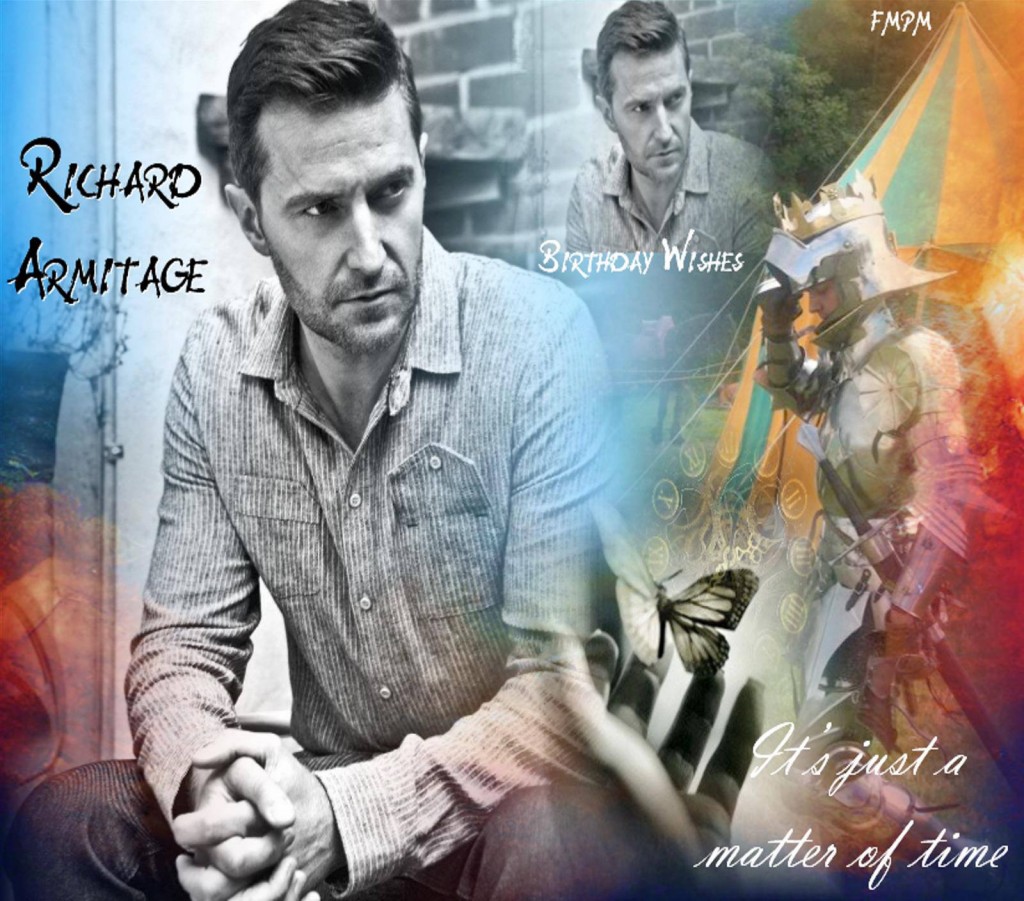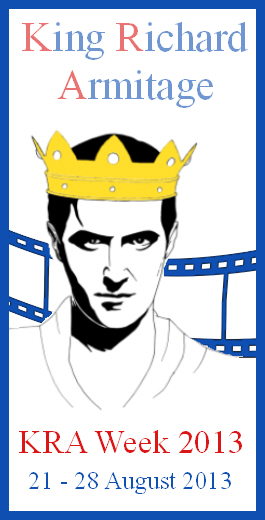KRA-Week 2013-5: Fitzg – Sumptuary Laws
Links: King Richard Week 2013 & Quiz
♕ ♛ ♕
SUMPTUARY
Sumptuary laws
in Medieval and late medieval England.
(by Fitzg)
“Laws made for the purpose of restraining luxury or extravagance, particularly against inordinate expenditure in the matter of apparel, food, furniture etc.”
Black’s Law Dictionary.
English Sumptuary Laws date from 1281 in extant documents. They were then an expression of the Feudal System (every man in his place, dressed according his station. Women too.) The hierarchy must be established according to the “natural law”.
The next documented Law is that of 1309. This relates to conspicuous food consumptions of the nobles. (Peacocks presented at table, complete with feathers re-attached to the roasted fowl…)
Perhaps Edward III felt that such expenditure by his magnates reduced their monetary contributions to his Scottish and overseas wars.
Obviously, Kings and their families were not restricted by such fiscal management restraints.

cloth of gold – Richard III earliest known copy of original; dated early 16th century (Source: Society of Antiquaries, London – Wikipedia)
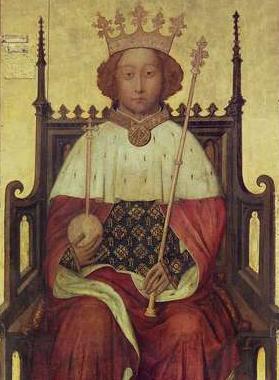
Richard II, c. 1390s. (Source: Westminster Abbey – Wikipedia)

Wilton Diptych (Source: National Portrait Gallery, London – Wikipedia)
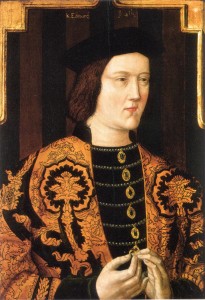
Edward IV. Portrait early 16th century (Source: Society of Antiquaries – Wikipedia)

Henry VII, c. 1505 (Source: National Portrait Gallery, London – Wikipedia)
Cloth of gold, fur, gold…. It appears that the first Tudor, despite a somewhat austere, penny-pinching reputation, at least in the popular version, was not averse to personal display.
However, there was considerable Church disapproval of courtly display of fashion “trends“. Shoes, in 15th C, were an issue with the Church: the vanity of the elongated toes.
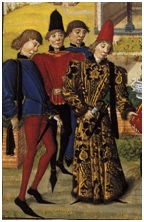 |
 |
 |
And then, there was the Disney head dress. The Henin, and variations thereof.

Hans Memling, Lady Donne of Kidwelly. The Donne Triptych, c. 1478 (Source: Wikipedia)
The middle class was rising in wealth, and becoming uppity in dress. Note the quantities of costly material in the sleeves and gowns and richness of dyes.

Hans Fouquet, the Melun Dipptych, c. 1452 (Source: Wikipedia)
Etienne Chevalier, was not a merchant, but a trusted civil servant.

The Arnolfini Wedding, Jan van Eyck, c. 1434 – Italian merchant and his wife (Source: National Portrait Gallery, London – Wikipedia)
Disconcertingly to the “enforcers” of the Sumptuary Laws, the merchant class rose inexorably. The merchant class accumulated wealth, based on wool and textiles, and import/export. They bought off the enforcers’ fines, and even lent funds to cash-strapped nobility. They were going to wear what they had earned. Their wives (and often mercantile partners/supporters) were an advertisement to their wealth and their often mutual hard work. (Take that, Enforcers! 😀 )
England has not been quite as rigidly class-ridden as might be thought – upward mobility was mobilised. From 15th century sheep farmers, the Churchills were Dukes of Marlborough two centuries later. A middle class was firmly rising throughout Europe, driven by trade – wool/textiles/luxury goods from the East. The sheep farmers became merchants (and money-lenders), married into gentry and titled families, became senior civil servants.
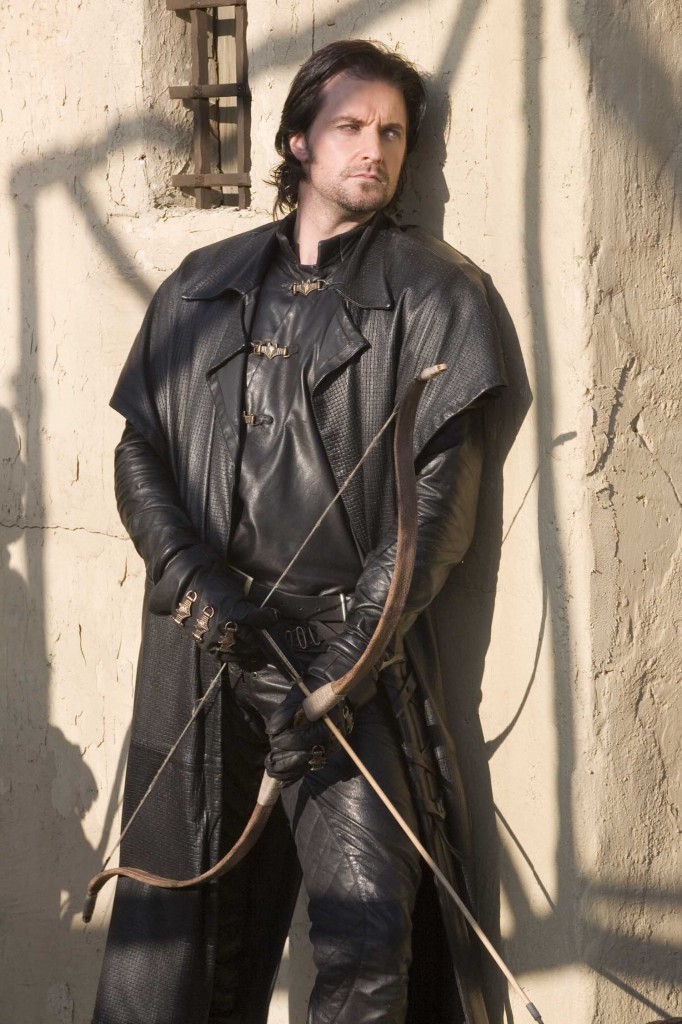
BBC “Robin Hood” Guy of Gisborne (Source: RichardArmitageNet.com)
Sir Guy of Gisborne, dressed head to toe in costly leather. Would a minor knight, in possession of an obscure provincial manor, pass the Sumptuary laws? Leather tanning and production were extremely costly, as is the case today. Perhaps; it didn’t involve cloth of gold or furs….
And Many Happy Returns to Richard Armitage on August 22 2013.
Respects to King Richard III, may he please be laid to rest as befits an anointed monarch.
SOURCES (for the costume-obsessed)
- www.medieval-life-and-times.info-medieval-clothing/medieval-sumptuary-laws.htm
- www.medieval-castle-siege-weapons.com/medieval-clothing.htm
- www.batashoemuseum.ca/collections/permanent/history_western_fashions/medieval/index.hstml
- Boucher, Francois. 20,000 Years of Fashion; Henry H. Abrams Inc. New York.
Links: King Richard Week 2013 & Quiz
KRA-Week 2013-4: Peter Warzynski & Leicester
Links: King Richard Week 2013 & Quiz
♕ ♛ ♕
Interview with journalist Peter Warzynski
about
Leicester & Archaeology & King Richard III
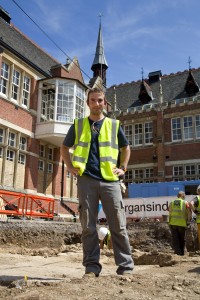
Peter Warzynski, Leicester Mercury – at the digging site where King Richard III was found. 7/2013 (Source: Peter Warzynski)
After yesterday’s interview with author Matthew Lewis, today we have an interview with journalist
Peter Warzynski from Leicester.
For all who follow the news about King Richard III here, he will not be a stranger.
Peter Warzynski is the knowledgeable reporter with the reliable news and information about Leicester and everything King Richard III. If the general news reports are vague about a topic, go find his article on the matter and you will certainly find the background and information you are searching for.
So I was very curious when Peter Warzynski wrote about his first hand experiences during the second digging at the location of the Greyfriars’ Church in Leicester in July 2013, and – surely not a daily occurrence for a journalist – I asked him for an interview, which he kindly granted.
The article in the Leicester Mercury with a fantastic picture of the digging area and his exact spot of research:
Leicester Mercury: Richard III dig: The hidden secrets of historic friary (20.07.2013)
And the description of his experiences during the archaeological research:
Leicester Mercury: Richard III dig: My brush with urban archaeology (22.07.2013)
With Peter Warzynski, I hardly could stop myself asking him questions. He is so knowledgeable about Leicester, has first hand experience about the digging, the location and the town.
Now, I hope you will enjoy the interview as much as I did while getting all my curious questions answered:
♛
Can you tell us a bit about yourself, your background as a journalist and your connection to Leicester?
I was born in Leicester, in the city, just a few miles from the car park where they found the remains of Richard III.
I’ve been a journalist for about eight years, starting at BBC Radio Leicester and moving to the Leicester Mercury about five years ago. I now live in Wigston, about five-miles outside of the city centre.
What is your impression about how the people of Leicester feel about the discovery and King Richard III himself?
I haven’t heard anything negative about the discovery from people in Leicester. Everyone is over-the-moon that we have a king buried in our city… and they’re even more excited about the fact that he will be reinterred at the Cathedral next year. Hopefully. The legal battle for the remains could push things back, but if the High Court sees sense it will make its decision quickly and the reburial can go ahead as planned.
The influence of Richard III in Leicester and Leicestershire is huge. We have the annual Battle of Bosworth re-enactment, we have roads, towns, schools and places named after him. We have statues, monuments and plaques dedicated to him. And we are in the process of building a museum in his honour.
How is the influx of visitors generally seen for / in the town?
Tourism is not our greatest industry, but we do fairly well.
Saying that, since the discovery of Richard III, it has boomed – and you can see that people are jumping on the bandwagon and using the king to promote their shops.
Advertising for local businesses suddenly has a Richard III theme and tour operators are offering packages to holiday makers which include all of the Richard III related sites.
More than 100,000 people have visited a small, temporary exhibition at the Leicester Guildhall, in the last few months. They have travelled from America, Australia, Asia in their droves and queued for hours to see the humble exhibition.
Next year a £4m permanent visitor centre will open, which will feature the grave of Richard III and is expected to attract millions of tourists.
It remains to be seen how long the initial explosion of excitement will last, but judging on how well people have taken to it, I think it’ll be a sound investment.
It had always been clear that King Richard III had been buried in Leicester after the Battle of Bosworth, but what does the knowledge that he indeed is there and finally found change for Leicester?
I don’t think it has always been clear. There was evidence to suggest he was buried by the Grey Friars, but where exactly that was has been a mystery for years.
Granted there was evidence to show that he was at the friary, but then again there was conflicting accounts to say he was elsewhere.
One of the main changes, now we know we have his bones, is the way Richard’s story is taught in school. Until the bones were identified, people still argued that his remains were dug up at some point in the past and thrown into the River Soar. That myth has now been quashed.
There is still quite a bitter debate over who identified the real location of the grave since the Greyfriars dig.
John Ashdown-Hill, who tracked down Michael Ibsen – Richard III’s 16th great grandnephew – claims he pinpointed the grave first.
However, the University of Leicester says that one their own – a lovely chap named David Baldwin – was the first person to positively identify the final resting place of the Plantagenet monarch.
Were you interested in King Richard III and his story before the digging in Leicester began?
Everyone in Leicester knows about the story of Richard III because he has had such a big influence on the city and the county.
As I mentioned before, the Battle of Bosworth is re-enacted every year. (In fact, this year, a German (Bavarian) man by the name of Andreas Wenzel will play the role of Richard at the anniversary re-enactment.)
So all Leicestershire folk have an interest in the former King – everyone I know has read Shakespeare’s imagining of him at school at some point.
I have an interest in history anyway, so this is very much up my alley (so to speak), and I the fact that history is playing itself out on my doorstep is fantastic. I also hope it will inspire others to become interested in history too.
King Richard III, though dead for over 500 years by now, still awakens great emotions, varying from hatred to support and loyalty. What do you think might be the reason for this heated debate about him, when other royals or historical figures can expect a more ‘neutral’ research into their life after such a long time?
Richard has polarised people for hundreds of years because nobody really knows what he was like. Or at least nobody knows the complete truth. There have been so many conflicting accounts written about him, it is impossible to determine what the man was truly like.
Did he murder the Princes in the Tower? Did he die bravely in the thickest press of his enemies? There’s nothing to sat he did both – or neither. This is the problem with trying to establish his character.
I believe that Richard ruled and acted like a typical medieval monarch. As far as people of the time were concerned, he was a conventional king.
I think that because very little is known about him, and due to a war of slander and deformation with Henry VII, what people think they know is shrouded in uncertainty – and it is very easy people to pick and choose what they believe and discount the pieces of history that don’t fit with their image of him.
The problem with my point-of-view of Richard is that by sitting on the fence I manage to alienate both the supporters and detractors with my boring uncommitted open-mindedness.
What did King Richard III and discovering his remains in Leicester change in your life?
Has your attitude / awareness for Richard III in your town (city) changed since the beginning of the digging? Was the digging you could join able to change your perception / perspective?
The discovery has changed the way I view archaeology.
I worked with the University of Leicester dig team on the second Greyfriars excavation, which finished a few weeks ago. It was at the same site and the grave of Richard was still visible – but this time the team was looking for more information about the friary itself.
The experience was like a roller coaster – one minute I was laboriously brushing the dust from the 50th broken tile I had found, daydreaming about what I was going to have for dinner that night. The next I was lifting the lid from a 600-year-old stone coffin to reveal what everybody thought would be a medieval knight, or the founder of the friary. I say ‘thought’, because what we actually found was a second lead coffin inside the stone tomb – a surprise for everybody, even experienced site director, Mat Morris – who found Richard a year ago.
After taking part in the dig, I realised just how unbelievably unfathomable it had been that the team had stumbled upon Richard’s grave the way they did.
When I spoke to Richard Buckley – who led the project – on the first day of the original Greyfriars dig in August 2012, he said he would eat his hat if they found anything. He was convinced the best the team would do is find part of the medieval friary – maybe the church.
So it goes to show how unexpected the find was.
Were you interested in archaeology before King Richard III was searched and found? If yes, why and how did you get information, what interested you?
What interests you now, after you have experienced a digging yourself?
I was interested in archaeology the same way most people are interested. I like books and documentaries about Egyptian tombs and Mayan ruins – not city centre digs.
Now, however, I think there’s something to be said for urban archaeology.
Since the discovery of Richard III, I have written a few more stories for the newspaper about other digs in Leicester – not connected with the Greyfriars – and I’ve learned a lot about the history of the city – who founded it, how the first settlers lived, when the Romans moved in, when the Romans moved out and how Leicester grew.
Digging so close where King Richard III was found, what aspect was more important to you. To get more knowledge about archaeology in general, about the history of your town or possibly about a famous king, who had gone missing some hundred years past?
I think all three tie in together. The more I found out about archaeology through working with the team, interviewing the archaeologists and reading about the project, the more I understood how amazing the story of Richard III was.
The University of Leicester maths department calculated that the odds of finding the remains was less than one per cent.
When you learn that only 17 per cent of the friary is not buried beneath buildings, walls or roads – that in itself is amazing.
If Richard had been interred anywhere else in the remain 83 per cent of the friary – which is unreachable – he would never have been found.
How important was the factor of good weather for your digging? What influence did it have on your results and speed of your digging?
It didn’t really have that much of an impact. The sun dried out the earth which made it difficult to photograph and catalogue because of the dust – it settled everywhere and made the whole place one uniform colour. It meant that details on stonework and tiles were indistinguishable from other nondescript areas. So before every photo was taken the whole site had to be hosed down and watered to bring out the detail and colour of the archaeology.
What methods did you see and were allowed to do yourself during the dig?
The dig process was mostly a meticulous one. First the heavy machines come in and remove the Tarmac and top soil. Then the archaeologists take over once they feel they’re close to the archaeology. My role involved using mattock – a type of pick – to carefully remove layers of soil and then once I’d come across something of interest – which mainly turned out to be medieval floor tiles – I would use a trowel and brush.
However, like I mentioned before I was also there when the stone coffin of Sir William de Moton (although it could be a number of other likely candidates) was unearthed, which was very exciting.
When we removed the stone lid, everyone expected to see a skeleton. But what we found was a second lead coffin inside, which is now at the university undergoing analysis.
In what aspects was archaeology more difficult and harder or easier than you expected?
Did the archaeological research and the used methods meet your expectations?
There’s a lot of manual labour involved. Shifting large wheelbarrows full of soil and debris from the excavation site.
One minute you’re heaving big clumps of dirt from the earth, and the next your being very careful because you’ve found ‘something’ which might be very interesting – and you have to change tact and be very gentle.
Anyone can do the bits I did. The hard part comes when you have to identify what it is you’re digging – and knowing when to stop smashing the ground with the mattock and use you trowel instead. Luckily, I was working with an experienced archaeologist the whole time – and I was probably asking very stupid questions.
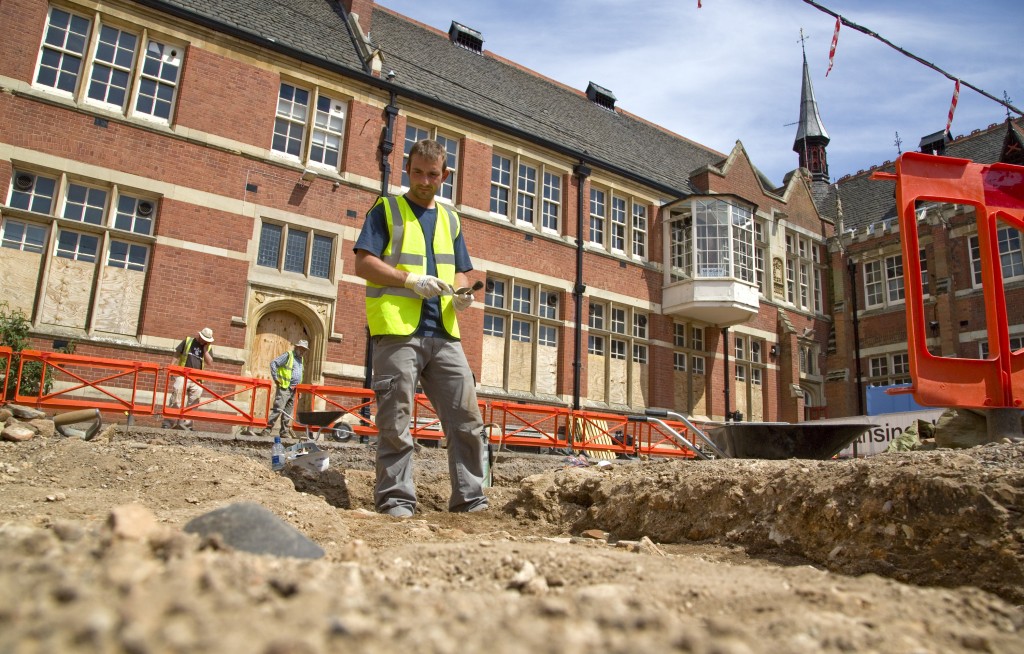
Peter Warzynski, Leicester Mercury – at the digging site where King Richard III was found. 7/2013 (Source: Peter Warzynski)
Your trench 4 looks rather level and not very deep, compared to some other trenches. Was this because of the richness of tiles already preserved in this upper soil section or did you later go deeper as well in a presumption that the area might have been filled in with debris from the destroyed monastery?
That was the top of the trench. Once the tiles had been catalogued and photographed we smashed right through them and continued deeper down. I was a bit taken aback by this. I thought we should be preserving them and removing them from the ground for storage.
However, it was explained to me that if the archaeologists did that with everything they found, especially the hundreds of broken tiles, they would soon run out of room to store them. They told me that the only way of finding out what was buried below their feet was to dig down, record what they had found and keep going. Much of the archaeology they came across was unceremoniously hacked through once it had been recorded.
This is the way it has always been, ever since the first archaeologist picked up a mattock.
Your trench looks very close to the grave of King Richard III. Can you tell us more about the placement of this section in the presumed church layout?
What area did you reveal in comparison to the location of where the grave of King Richard III was situated? Had you hoped to find something with significance to King Richard III in the church?
The site that was being excavated was the choir of the church. A place where only the friars could go.
It was reserved for high status burials and the team actually uncovered – but did not exhume – a number of other remains during both digs.
It faces east to west, as is the tradition with churches, and included a presbytery – where the stone coffin was unearthed. To the north was the friary’s graveyard, which extends under the neighbouring building and the road which separates the site from the Cathedral (where Richard will be reinterred next year).
The second dig was not aimed at finding anything else directly related to Richard III. Historical records say that Henry paid for an alabaster tomb for Richard, but that was never found. It would have been interesting that had been uncovered.
The second dig was aimed at finding out more about the friary itself.
Might King Richard III have been able to make archaeology more popular?
Will superficial observers now, after King Richard III was found so quickly, think archaeology is a fast method? What impression did you get?
The way Richard III was found is certainly not common in archaeology. Archaeologists do not look for specific people – that is very rare. What archaeologists do is dig and see what they find. To go out with the specific intention of finding a particular person is almost unheard of, which is what makes this story even more fascinating.
So, with that in mind, this project might give people the wrong impression about archaeology.
The discovery has also kick started media speculation about other English kings and their presumed whereabouts, and there have been stories in the newspapers about searching for Alfred the Great.
I suppose people might think that archaeology is fast and easy after following Richard’s story. After all the team found him on the morning of the first day of the dig, in the first place they looked, in the first trench that they dug.
Will you attend the burial ceremony of King Richard III next year? What are you looking forward to most? What aspect of the ceremony do you think especially reflects on the person of King Richard III? What aspects do you think – as far as they are known so far – are more to appease contemporary sensibilities rather than King Richard III?
I will definitely be at the reinterment ceremony next year to report on the event, speaking to visitors from far-flung lands and enjoying the occasion for myself. I can’t wait. I’m also working with the cathedral on the plans at the minute, and I’ve been sworn to secrecy regarding the details of the service. Although, they haven’t really told me that much – I think they are still quite distrustful of the press.
The cathedral is not used to this kind of media attention (unlike the university and the city council) and I think it feels slightly uncomfortable.
Despite the judicial review into the exhumation licence, I still think Leicester will be the location of the reinterment. So I’m not worried about York snatching the bones from under our nose.
They could be famous last words, but common sense, and the law is on Leicester’s side. The spurious claims of the Plantagenet Alliance – that they are in some way related to the king – will be shot down within seconds. Richard III has millions of relatives in the UK, with an equal right to the remains.
The fact is, after 500-years, almost everyone in England who can trace their family tree back to the 15th century will find some link to Richard.
This is why the High Court judge, Mr Justice Haddon-Cave, has agreed to hear the case, because he says the country should decide. But then by allowing the debate he’s giving priority to what will only amount to an argument, rather than to the law – which the University of Leicester followed to the letter when they applied for the exhumation licence.
Whom would you invite to attend the burial ceremony, if invitations were left in your hands?
I do think there should be a member of the Royal Family there.
What is your impression of King Richard III now, after all your experiences and your intense occupation with the research? What is your impression now, in comparison with what it was before the search in Leicester even begun?
There has been a lot written about how he has been misrepresented throughout history. I think the argument that he wasn’t as bad as people say does have its merits, but I still think he would have behaved like a monarch of the time – and that means he may not have been a complete angel either.
But whatever kind of king he was, he was buried in Leicester… and Leicester is where he should stay.
♛
Now I am certain you see, why I had such a hard time to stop myself from asking questions from my interview partners.
I hope you enjoyed both interviews with Peter Warzynski and yesterday’s with author Matthew Lewis.
More articles and interviews will follow in the next days.
Don’t forget to take part in the Quiz till the 27th at midnight to have a chance to win!
(Though it starts with questions about actor Richard Armitage, most questions are about King Richard III !
So it is not only for RA-experts, but for history buffs as well!)
Links: King Richard Week 2013 & Quiz
KRA Week 2013-3: History & Law – Author Matthew Lewis
Links: King Richard Week 2013 & Quiz
♕ ♛ ♕
Interview with author Matt Lewis
about
his research & King Richard III
First of all, I need to confess, having such a knowledgeable author and researcher as interview partner let my curiosity run away with me. I hope you will enjoy the wonderful and insightful answers by author Matt Lewis.
Matt Lewis also currently publishes a series of articles in defence of King Richard III on the Royal Central blog
- The Real White Queen? A Defence Of King Richard III (02.08.2013)
- The Defence of Richard III Part 2 – The Foundations of Evil (06.08.2013)
- The Defence of Richard III Part 3 – To Kill A King (11.08.2013)
- The Defence of King Richard III Part 4 – Bosworth, Shakespeare & That Horse (22.08.2013)
and an interview by Karen Kilrow with more background was published there (13.07.2013).
But now to the interview and my curious questions:
Can you tell us a bit about yourself and your historical background?
I have been passionate about history since school, where it was my favourite subject. I studied the Wars of the Roses there and it immediately grabbed me. The intricacies of the family ties, the loyalties and the betrayals are like the plot of the most complex tv series you ever watched, only this was real people’s lives being torn apart.
The story of Richard III was also something I was immediately fascinated by. The difference in his reputation before 1483 and after was so diametrically opposed that it just didn’t make sense. I had to learn more! An interest became a passion. I read book after book about the Wars of the Roses and Richard III and the more I read the more convinced I became that something was amiss.
How does your legal background fit into your interest for history?
At university I studied law and even that seemed to complement the study of history. I find that having a law degree complements an interest in history very well. A solicitor I worked for once told me that no one knows all of the law, the trick is knowing how and where to find what you need. This principle applies to history too. No-one knows all of history.
The skills of research are the same. A law degree teaches you how to find facts, examine and understand them from all angles, to view things from the perspective of others and then present your findings. Historical research is identical. When writing fiction, legal training helps further because it teaches you to understand the facts and then make them prove what you need them to prove!
Why is it so difficult to get unbiased research into the life and times of Richard III, even more than 500 years after his death?
It is hard to understand why Richard III doesn’t get the kind of impartial study almost anyone else does. I think it is due in part to history, for purposes other than academic study, liking to box people up neatly as ‘goodies’ and ‘baddies’. The Tudors followed Richard and were keen to present a picture of an England ravaged by tyranny from which they saved a grateful people. Obviously he was then maligned by Shakespeare and that image of him stuck. There has always been a core of historians keen to shine the light of fact on his reputation but it has been hard to fight against a presumed, accepted image. Because of this the argument becomes more polarized as some believe him an evil tyrant and others try to paint him as a saint. Somewhere in the middle the real man is lost. He was neither a saint nor a demon and until the argument moves away from such passionate polarization it will always prove hard to judge him dispassionately.
Might this difficulty to get some resemblance of ‘justice’ for a historical figure have something to do with the current royal family descending from those getting into power after the Battle of Bosworth or the perception of a need to legitimize the later religious separation from Rome or have something to do with a modern interpretation of what monarchy and democracy should be or do?
I think that the present royal family have little impact on the study of the history of personality. They would, I suppose, have a vested interest in the institution of monarchy and so would not wish to become embroiled in any kind of discussion of rights and wrongs. To do so opens them up for such criticism in the future. It is for this reason, I suspect, that the royal family is not keen to allow the opening of the urn in Westminster that supposedly contains the remains of the Princes in the Tower and of other royal tombs such as Edward IV’s for DNA comparison. I doubt that it relates to insecurity or rivalry but rather to the sanctity of those graves. There are human beings resting in peace there. If permission were given now, the same could happen in the future to those still alive now and they may well not want that. Whatever the rights and wrongs of Bosworth, Henry VII was anointed king, whether by right of blood or conquest becomes irrelevant. No-one could challenge the legitimacy of the current royal family now on that basis. If we look further back, Edward IV took the throne by force, as did Henry IV. Do we then head back to William the Conqueror?
Will finding the ‘real’ King Richard III now help with the research to also start the search for the ‘real’ person, not the legend?
The discovery of Richard III’s grave is an opportunity that I hope will be exploited to the full by those seeking a re-evaluation of his reputation. I noticed a real surge in sales of my novel when it was announced, so clearly interest has been captured and just needs to be exploited. The White Queen series has drawn attention to the Wars of the Roses period too. Visitors are pouring in to the exhibition at Leicester and I hope that they will be taking away a different perspective on him, if they are not already Ricardians! I was lucky enough to visit the dig site at Greyfriars on one of the open days and it sent a chill down my spine to think that I could be standing so close to the remains of a man I had studied for so long. I was like a crazed fan. I find it amazing that after everything that has happened on that site – the demolition of the monastery, the building of the mayor’s house and gardens, the demolition of that and all of the subsequent Victorian work, not to mention the laying of the car park – that his grave remained intact and unspoiled, missed by every pick axe and digger that had been on the site. His funeral will be another huge event, unlike anything we have seen before. It would be fantastic to make it there and I will be doing my best to attend some part of it.
I hesitated a bit with the following question, not wanting to heat up the brewing battle. But Matt Lewis answered my question about King Richard III’s last resting place with grace and historical knowledge, so I need not have worried:
With all the discussion about the ‘Battle of the Cities’, what is your position regarding the fighting towns York and Leicester?
In terms of where he should be laid to rest, I have no issue giving my preference. From the very outset there has only been one place that I believe he should be buried and that is Westminster Abbey. He was a king of England and deserves no less. Much has been made of Leicester’s right to him and York’s desire for him. Indeed, it has been claimed that he wanted to be buried at York Minster. Whilst he was lord of the north for his brother this may have been his intention but by the time that he died he was King of England. The clearest indication of his final wishes is the fact that he had his wife buried at Westminster. He may well have intended to have their son moved there from Middleham too, but I think Anne’s presence at Westminster tells us all that we need to know about his wishes.
How do you see the legal aspects of the appeal by the relatives of King Richard III, the Plantagenet Alliance?
The legal challenge that has been brought is flawed in so far as those bringing it are not descendants of Richard III, they are descended from his siblings. It is also my understanding that the reburial of remains discovered during an archaeological dig does not require consultation with the relatives where the remains are over 100 years old, as those of King Richard clearly are. Best practice is to have remains interred at the nearest church or cathedral to the location they were discovered too. Leicester University appear to have done all that was required of them and I suspect that their wish to have him buried at Leicester Cathedral will be, in the end, granted.
You wrote a historical novel about Richard III, clearly depicting Richard III as human being, not the caricature not only Shakespeare, but also some historians made and still make him.
What is your reason to do so and where do you see you have to add to all the previous works and novels about Richard III?
I wrote my novel as an indulgence really. It took about 10 years of picking it up and putting it down but I enjoyed writing and researching it. I tried to remain as historically accurate as possible, not least because the true story is far too interesting to have to invent anything! The book looks at the more domestic side of Richard’s life from the Battle of Barnet when he helped his brother Edward IV regain his throne to Bosworth. Most people know about the battles he fought, the seizure of the throne, the Princes in the Tower and the Battle of Bosworth but I wanted to explore him as a more rounded person, at home with his wife, relaxed with his friends, but still dealing with huge issues of national importance. ‘My’ Richard has faults, too. He is far from perfect. His temper is short and his inability to understand those who do not share his views leave him politically naive and exposed. The actions that he takes in the book broadly follow the known history, so if he attracts sympathy for his actions, it is because he deserves it.
Whatever you decide about him by the end, at least it will be based on fact rather than accumulated mythology.
Studying law helps to view things dispassionately, to detach from them and present them objectively. I am an ardent Ricardian, though I don’t necessarily belief he was without fault. I hope that by presenting a man trying his hardest to make his way in a hostile, uncertain world, struggling to protect his family, I could balance out the saint v tyrant argument a little.
To what extent is your work “Loyalty” based on the research by Jack Leslau about the image interpretation and connection between Sir Thomas More and Hans Hobein? (Research presented on the website: www.holbeinartworks.org)
I first read a brief reference to Jack Leslau’s work in A.J. Pollard’s King Richard III and the Princes in the Tower. It fascinated me and I read more. The more I learned the more interesting it became. In the end it provided the frame through which Richard’s story is told, so there is no doubt that it influenced me a great deal. Ricardians will probably know what that means for the story, but it is not well discussed beyond this. The sequel, which is nearing completion, follows both threads of this story to something which I believe is entirely new. At least I have never come across my next theory before! Holbein returns and we also follow the aftermath of Bosworth as those loyal to Richard who survive try to find a place for themselves in a changed world, a world that hunts them.
You wrote two further works about King Richard III and the Wars of the Roses. Both are rather short volumes with highly condensed information, giving an excellent overview of events and happenings.
What was your reason to write those and for which audience are they intended?
I have begun a series of brief factual history books offering my take on the period I love. A Glimpse of King Richard III was born of the new interest in the king and is a very short biography. It is aimed squarely at those interested in the subject because of the recent discoveries and discussions but who do not wish to dive into a weight biography – though I enjoy these immensely, they are not for everyone. I thought those with a casual interest might pick it up and hopefully put it down with a different perspective on King Richard III. A Glimpse of the Wars of the Roses adds depth to the subject but is also brief, beginning with the roots of the conflict and then following the chronology of the politics and the battles. Again, with interest high and The White Queen drawing much attention, I thought some with a more casual interest in the period might find it interesting. There is more to come in the series too. Hopefully people will enjoy my lighter take on the complexities of the period.
Book publications currently available by Matthew Lewis on Amazon.com / Amazon.co.uk
:
* * *
* * *
* * *
Links: King Richard Week 2013 & Quiz
KRA Week 2013-2: Happy Birthday & Commemoration
Links: King Richard Week 2013 & Quiz
♕ Happy Birthday ♕
♕ King Richard Armitage ♕
Two years ago, our present was a ‘virtual’ cake accompanying our online-present, the first King Richard Week 2011. We already hesitated to send a cake for our second King Richard Week 2012.
Delicious as it may look, it does not really taste that way.
This year we want to show, what present we (the fans and petition signers) would much rather like to give and of what presents we dream about.
Hopefully, it is ‘just a matter of time’ as Fernanda Matias writes, till this dream can become reality.
Tanni Tani starts with giving ‘our’ King Richard the white rose of York:
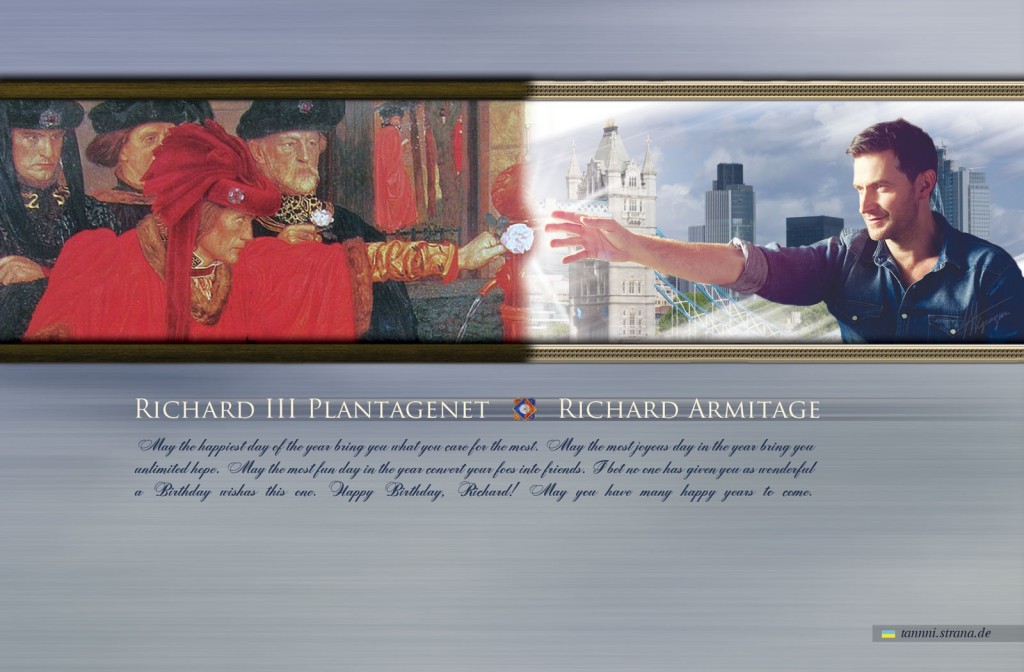
(Source: © Tanni Tani – White_Rose5)
While Michelle Jimenez-Porras created a new portrait, showing the progress on her blog MyDebonairAffair:
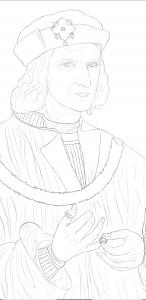
First draft (Source: © Michelle Jimenez-Porras – at Deviantart.com)

(Source: © Michelle Jimenez-Porras – at Deviantart.com)
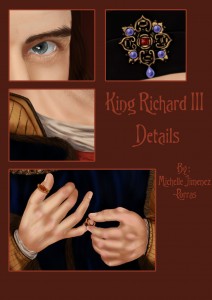
(Source: © Michelle Jimenez-Porras – at Deviantart.com)
Gratiana presents Richard Armitage in his historic role and dignity:
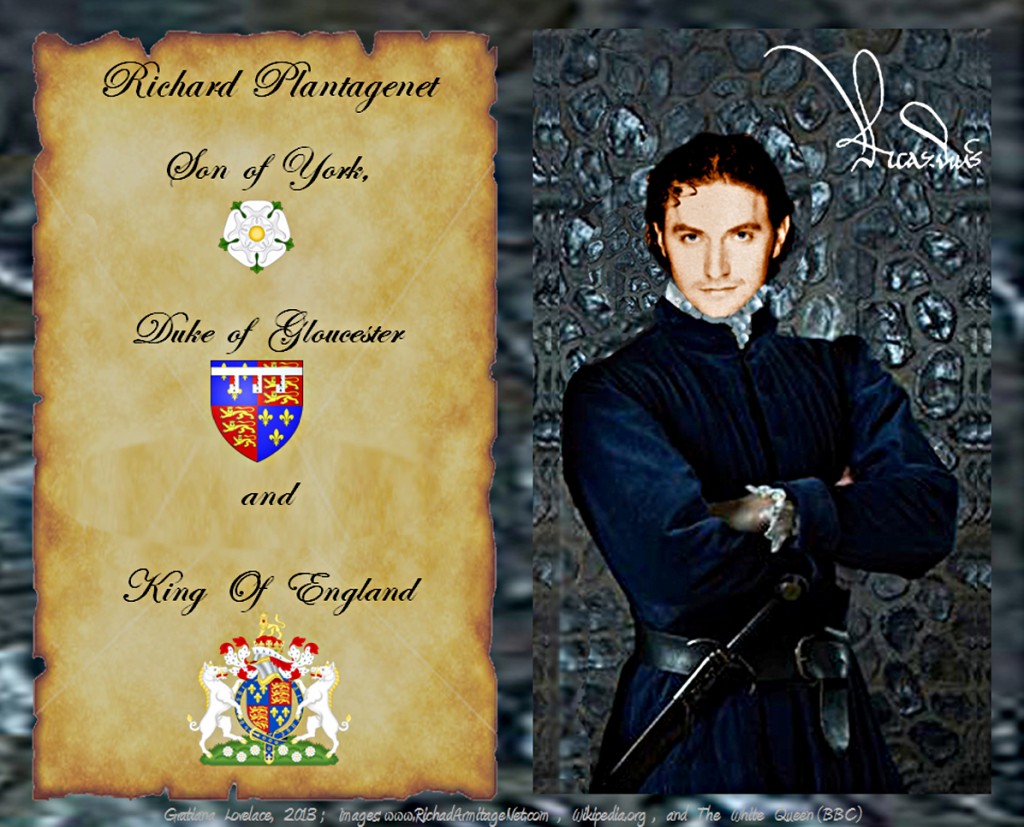
(Source: © Gratiana Lovelace)
♕ Happy Birthday ♕
♕ King Richard Armitage ♕
Links: King Richard Week 2013 & Quiz
KRA Week 2013-1: The Beginning – Quiz-Prize & Historical Literature – Author Isolde Martyn
♛ KRA Week 2013 ♛
The KRA Week 2013 begins…
Gratiana Lovelace already spread the word about KRA week. Have a look at her wonderful image of King Richard III Armitage !
We will have daily posts on the KingRichardArmitage website and a variety of posts will appear on participating blogs.
Our posts will vary from fan-appreciation to a wide selection of interviews here on KRA.
Participants of the Quiz throughout the week (till 27 August 2013, till midnight [GMT]) will participate in the drawing and can win one of our two print versions of “The Devil in Ermine” by Isolde Martyn. (More details here.)
We will keep you updated on this central page of the event, where all links and posts are collected:
King Richard Week 2013
We hope you will enjoy the event and the wonderful knowledge shared by our interview partners
and wish you a good and enjoyable time with lots of Mr. Armitage-celebration and information about and around King Richard III.
Best wishes,
CDoart
♛ Quiz ♛
Procedure:
Simultaneously to this post, the quiz is opened up and the quiz questions become available.
As those who participated in the congenial quiz by quizmaster Servetus last year already will know, we request of you to enter your name and e-mail address to participate.
This is to ascertain that we can select a winner for the quiz, but also to avoid spam and double entries.
As we want to make the quiz fun for all participants, we have some security measures in place, so that you can enjoy the participation. This also necessitates a few security questions, but we tried to keep them at a minimum.
Your mail and data will not be shared, but is only used to execute this quiz.
Please note:
Quiz entries till the 27th of August, 2013 till midnight (GMT) take part in the drawing
and among the most complete and correct answers the two winners will be selected by random number.
We have two print-book give-aways about a very central aspect and turning point of King Richard III’s life.
We hope the lucky winners will enjoy this insightful historical novel by Isolde Martyn.
More about this book and its author here:
♛ The Devil in Ermine – Isolde Martyn ♛
Author Isolde Martyn
with her extensive knowledge about King Richard III and his life, has supported us here on the KingRichardArmitage website already with a presentation (interview 26.08.2011) of the Australian research group
The Plantagenet Society of Australia.
and also gave us an interview (14.03.2013) about her book about Jane Shore, mistress to King Edward IV, “Mistress to the Crown”.
In this interview presentation in March, I had already announced Isolde Martyn’s new book “The Devil in Ermine” coming out soon and reviewed my pre-version a bit:
I am currently reading Ms Martyn’s book “The Devil in Ermine“, which will come out shortly (Yes, I have a pre-version ;o)
And I can tell you, I can’t recommend it highly enough. I am in total awe of this well researched and gripping depiction of the decisive year 1483 in King Richard III’s life seen and told from the perspective of his cousin, the Duke of Buckingham.
The revolt by Buckingham, the reasons, the background are so well told that I really feel for the characters described in the book and see all the motives so well coming together and building the story. The book really has gripped me.
(I will let you know as soon as the book becomes available. – I know I am cruel here, stoking your curiosity, while I am already reading it ;o)
I am really happy to be able to have this wonderful book as our prize of this year’s quiz.
I hope the quiz winners will enjoy it as much as I did.
Isolde Martyn’s insightful and well researched interpretation of the upheaval and intrigues of the year 1483, the year King Richard III came to power and is betrayed by the Duke of Buckingham, is gripping like a crime novel.
To my surprise, I must admit, as I am normally hesitant with historical fiction, but rather read historical research. But Isolde Martyn’s fictionalisation is so very fact based and for me was such a psychologically understandable version of the events, that all the intrigues and motivations of the historical figures acting so wildly during the year 1483 finally came together and made sense to me.
So to all who want to get a clearer understanding to why King Richard III changed so much at the beginning of his reign and could not become the benevolent and magnificent king he could have been and would have had the ability to become, I recommend this highly fascinating revelations.
Take your chance and take part in the quiz to win one of our two print-editions of “The Devil in Ermine” here.
♛ Battle of the Cities ♛
- Helen Rae Rants! (Blog): Please: Richard of Gloucester, not York! (17.08.2013) – The whole discussion about the right burial place for King Richard III brings up so many emotions. This article very well brings the whole discussion to its basic facts. Very interesting to read!
- Leicester Mercury: Richard III: Leicester’s burial plans for king dealt a body blow, Peter Warzynski (17.08.2013)
- Leicester Mercury: Richard III: ‘Spurious’ case costs £28,000, by Dan Martyn (17.08.2013) – Monetary priorities in case of King Richard III.
- ThisIsLeicestershire.co.uk: Mercury opinion: The fact is the king belongs here, Leicester Mercury (17.08.2013)
- Leicester Mercury: Richard III’s remains ‘will stay in Leicester’ (19.08.2013) – The late legal decision regarding the Plantagenet Alliance’s claim eventually might not affect the end result, but causes a break in the proceedings.
- Leicester Mercury: Richard III: Relative wants Leicester burial for king (21.08.2013) – Appeal by Michael Ibse, 17th generation relative to King Richard III, to sign the petition for Leicester (only available for U.K. citizens).
♛ King Richard III ♛
- HistoryExtra.com: How re-enactment could one day help us understand the final moments of Richard III, by Chris Skidmore (16.08.2013)
- ThisIsLeicestershire.co.uk: Richard III: The battle goes on, by Dan Martin (19.08.2013) – Report about the commemoration re-enactment of the Battle of Bosworth last weekend.
Petition Signatures
We once again accumulated such a high number of unconfirmed signatures (over 200).
As those signers might have overlooked the first confirmation mail, we send out new confirmation mails today.
Thank you !
News Breaks – Relatives Claim Accepted – King Richard III Worth a Precedent
♛ Battle of the Cities ♛
The appeal by the distant relatives of King Richard III, who formed the Plantagenet Alliance, has been granted. They now have permission to get a judical review of the decision for Leicester as the last resting place.
- BBC News: Richard III: King’s reburial row goes to judicial review (16.08.2013)
- Sky News: King Richard III’s Family Set For Court Battle (16.08.2013)
- itv.com: Where will the remains of Richard III be buried? By Nimesh Joshi (16.08.2013)
- The York Press: Judicial review over King Richard III burial, Dan Bean (16.08.2013)
- Huffington Post: King Richard III Relatives Win Right To Challenge Burial Plans (16.08.2013)
- Royal Central: Richard III’s relatives halt plans to bury King in Leicester, by Charlie Proctor (16.08.2013)
- The Lawyer: Gordons secures judicial review for Richard III’s descendants, by Joanne Harris (16.08.2013) – Law firm Gordon from York is representing the group of relatives, assembled in the Plantagenet Alliance. The article gives more legal and argumentative background for the desicion made by Mr Justice Haddon-Cave.
- ThisIsLeicestershire.co.uk: Richard III burial: Legal challenge to go ahead, by PA_Warzynski, Leicester Mercury (16.08.2013) – This article also contains a link to the pdf-file of the High Court ruling document.
- ThisIsLeicestershire.co.uk: Richard III legal battle: University of Leicester ‘sticking to its guns’, by PA_Warzynski, Leicester Mercury (16.08.2013) – The University of Leicester is not deterred by the current decision and is proceding with its plans.
The University of Leicester issued the following official statement today:
The University maintains that it is entirely proper and fitting that the remains of Richard III, Duke of Gloucester, be buried in the magnificent holy setting of Leicester Cathedral, near where his remains had lain for centuries and where they were finally discovered as a result of what the court described as ‘the inspired, determined and meticulous work’ of the University and members of the Richard III Society. The University will now liaise with the Ministry of Justice with a view to ascertaining how it wishes to proceed.
And notes:
- The Dig for Richard III was led by the University of Leicester, working with Leicester City Council and in association with the Richard III Society. The originator of the Search project was Philippa Langley of the Richard III Society.
- Dr John Ashdown-Hill was instrumental tracking down the descendants of Richard’s sister Anne of York, Joy Ibsen and her son Michael Ibsen, whose DNA, along with that of a second individual traced by Leicester academic Professor Kevin Schürer, was critical to identifying the remains found at Greyfriars in Leicester.
♛ King Richard III ♛
- ThisIsLeicestershire.co.uk: Actor takes on the role of Richard III, by Peter Warzynski, Leicester Mercury (15.08.2013) – German actor Andreas Wenzel will impresonate King Richard III in this year’s reenactment at Bosworth Battlefield.
- The Huddersfield Daily Examiner: Huddersfield historian Glenn Foard unveils new theory on Richard III, by Neil Atkinson (15.08.2013) – New research about the actual location of the battlefield and the place where King Richard III near Bosworth.
- HistoryExctra.com: Historians identify ‘spot where Richard III was killed in battle’, by Emma McFarnon (15.08.2013)
4 More Days …
… till our celebrations and commemoration week begins …
King Richard Armitage Week 2013
is coming up fast!
21st – 28th of August, 2013

The page for the event is already created and available, though content there will be added from 21st of August, 2013, the beginning of the event, onwards.
Safe the date, take part in the upcoming quiz during the event week and enjoy fan-tastic history with us.
A few days more to live …
Not only happy memories are connected with the 22nd of August, though surely a certain Birthday lets the fandom of Richard Armitage celebrate this day. (You can leave your Birthday Wishes at specially destined places in the fandom. Thankfully Servetus created a special list of the options, to help you find the place of your choice.)
What makes this time in August especially significant to me is the fact that King Richard III’s remains were found on the estimated day his remains were buried by the Franciscan friars in their church in Leicester. So maybe the king has a certain sense for anniversaries and their special significance.
In this sense, let’s celebrate and commemorate his life, the life of a wonderful actor and the sensational find, bringing all strings magically together – in Leicester.
Commemoration and Re-Enactment of the Battle of Bosworth
begins already before the actual event
on Saturday, 17th of August 2013 !
For more information, please visit the Bosworth Battlefield website about this year’s:
Anniversary Re-Enactment of the Battle of Bosworth (17./18.08.2013)
♛ King Richard III ♛
- Liverpool Daily Post: I can’t accept Richard III sounds like a pantomime country bumpkin with a terrible nose cold, by Laura Davis (08.08.2013) – I am not alone with my reservations. Though my doubts are more along the lines of the well nourished head replica, while King Richard III in sources is mentioned as rather slim and ascetic looking, which the portraits – unfortunately no exact one survived from his lifetime – would confirm.
- The Framework Blog: August Is Hot: Proud Moment, by Violet (12.08.2013) – Violet discovered
sensational news
about the film project and the developed script by Philippa Langley. The name “Blood Royal” for the script is revealed on her publisher’s website: Macmillan, where her next book “The King’s Grave” is due to be published in October 2013. Read more about Violet’s discoveries here!
“Blood Royal” reminds me quite a lot about the genealogy of the Plantagenet.
Here e.g. The Clarence Volume: “The Plantagenet Roll of Blood Royal […]” by the Marquis of Ruvigny and Raineval.
The Preface might especially be interesting for someone researching European Royalty. - Royal Central: The Defence of Richard III Part 3 – To Kill A King, by Matt Lewis (12.08.2013) – See also the previous parts in this series of defence by Matt Lewis: part 1 and part 2
- Science 2.0 (Blog): Battle Of Bosworth – The Last Stand Of Richard III Located (14.08.2013) – Interesting article, though the result and statement “Richard III. Popular among no one in England” may be arguable – as it certainly does not pay off for a king to champion those who cannot write and bring their voices to paper for later generations to hear, against someone who willingly manipulates the story told by paying for his own version and destroying the rest.
- White Rose: Sincere and Simple Thoughts (Blog): King Richard Armitage Week 2013 Coming Soon, by Fabolaktuko (14.08.2013) – Please note the name of the blog. Fabolaktuko will join next week’s KRA-event !
- ThisIsNottingham.co.uk: Scientists work to reveal secrets of King Richard III, by Bryan Henesey (14.08.2013) – Scientists are trying to find out more about the life King Richard III lead, what he ate, what illnesses he had, where he lived and traveled, …
Results of the research by Prof. Jane Evans and Dr. Angela Lamb are expected for the end of 2013! - FirstThings.com (Blog): Perry Dane on Richard III (14.08.2013) – Comment to the original article we mentioned in last week’s news updates about the rite for King Richard III‘s burial ceremony by Mark Movsesian.
♛ Richard III – Events ♛
- 17./18.08.2013
Anniversary Re-Enactment of the Battle of Bosworth
(Bosworth Battlefield Centre) - 23.08.2013, 2:30 – 4:30 p.m.
York in the Reign of Richard III, by Chris Tuckley (at the Yorvik Viking Centre)
More details here on the VisitYork website.
Closer to the Day …
♛ King Richard III ♛
- PR.com (PressRelease): Richard III: Martyr or Monster? The Shocking Truth Behind Shakespeare’s Bloody Tyrant, by Kultur International Films Ltd (01.08.2013) – This film production by does not seem to be connected with the video-DVD of the TV documentary in two parts “Richard III: The King in the Car Park” and “Unseen Story”, though I can’t find the title on the Amazon.co.uk website yet.
As announced on this Kultur-website, the DVD will become available on 27 August 2013. A short trailer is already available on this site as well.
- Royal Central (Blog): The Real White Queen? A Defence Of King Richard III, by Matt Lewis (02.08.2013) – A very enlightening background comment about the TV series “The White Queen”.
An interview with the author of this post can be found here: Interivew with Matthew Lewis – author of the book “Loyalty”, by Karen Kilrow (13.07.2013) - InLoughborough.com: Bosworth buzzing about first re-enactment since Richard III discovery (02.08.2013) – This year’s Bosworth Battlefield Re-Enactment Event is taking place on the weekend 17th/18th of August, 2013.
- University of Leicester: Emotional end of final dig at Richard III site (05.08.2013)
- Royal Central (Blog): Anne Neville – The Bad Queen? By Sean Okeeffe (05.08.2013) – Was Anne Neville, the queen about which history has nearly no reliable resources at all, really the bad queen as whom she was depicted in the latest episode of “The White Queen”?
- Royal Central (Blog): The Defence of Richard III Part 2 – The Foundations of Evil, by Matt Lewis (06.08.2013) – Was King Richard III guilty of all the crimes he was accused of? Follow this gripping series of articles by author Matt Lewis, exploring the background and coming to a verdict at the end of each article.
- IsleOfMan.com: Richard III, the king in the car park, is coming to the island (05.08.2013) – That now would be a resting place for the king. Sorry ! Don’t want to heat up the discussion again, but the headline lead my thoughts astray. The king unfortunately is not coming himself, but Richard Buckley from the University of Leicester, as the further article on the Isle of Man website ‘King in the Car Park’ Archaeologist to visit the Island, by Charnwood Tails (05.08.2013) reveals.
- Leicester Mercury: Richard III: Historian claims he was ‘airbrushed out of king story’, by Peter Warzynski, Leicester Mercury (06.08.2013) –
Quote of a ‘Spokesman’ for the University of Leicester:We had to go through Richard’s lineage again, and verify the work which was carried out more than 10 years ago. We can’t have everyone at the press conference. Perhaps we should have invited the creator of DNA fingerprinting as well, seeing as he played a part?
This in my opinion for once is a situation, where a ‘spokesman’ should not have spoken, but rather should have taken the time to research the background of the topic he was talking about. Dr. Ashdown-Hill over years researched the connections and relationships and later irrelevant sidelines, to find the valid one leading into our time, which could possibly be used for a DNA analysis. The University of Leicester – don’t think I am making accusations here as their work is a valid and necessary one as well – just had to confirm an already extensively researched line of ancestry and could rely on the previously done work, which in total was a matter of mere months.
As this is only one aspect of many, where the finding of King Richard III heavily relied on the previously done work by Dr. John Ashdown-Hill, that is really not the best way to cope with one of the main contributors to the search. - First Thing: No Catholic Burial for Richard III, by Mark Movsesian (06.08.2013) – See what religion and strawberries have in common.
- My Debonair Affair (Blog): King Richard III, by michellejimenezp (07.08.2013) – New art project for Richard Armitage as King Richard III ! Updates about the progress of the painting will follow shortly.
- ThisIsLeicestershire.co.uk: Richard III visitor centre gets go-ahead, by DanJMartin (07.08.2013)
- BBC News: Richard III museum plans in Leicester approved (07.08.2013) – With a few more pictures of the planned center than the previous article, though no further information.
♛ KRA – Announcements ♛
King Richard Armitage Week 2013
is coming up fast!
21st – 28th of August, 2013
The page for the event is already created and available, though content there will be added from 21st of August, 2013, the beginning of the event, onwards.
Safe the date, take part in the upcoming quiz during the event week and enjoy fan-tastic history with us.

To Accomodate a King
– – Sorry for the delay with the news updates,
but a journey and real life intervened. – –
At the moment, a lead coffin found near King Richard III gets all the media coverage, using the general interest for King Richard III to gain attention. Though what this discovery should add in knowledge about King Richard III is not entirely clear to me, as the burial is in no connection to King Richard III, except that it is in close range and might have some significance regarding the financial and social status and influence of the Grey Friars in Leicester in general.
I don’t know if the next grave to my family in the burial ground at home will tell later generations something about me, at least not much more than that at one point a priest must have come to the decision to put the graves next to each other. So I don’t trust that the new discovery in Leicester will be able to tell us anything about King Richard III, but we will see.
♛ King Richard III ♛
- The York Press: Replica of Richard III’s head goes on show at the Yorkshire Museum in York, by Kate Liptrot (19.07.2013) – King Richard III, at least his head, currently resides in York, in the Richard III Museum, till October.
- The Telegraph: Let’s give Richard III the last great Gothic tomb in Britain, by Harry Mount (19.07.2013)
- ThisIsLeicestershire.co.uk: Richard III will be buried in raised tomb, by Peter Warzynski, Leicester Mercury (19.07.2013) – I am very glad to read that plans to take the bones of King Richard III on a procession to and from Bosworth Battlefields to the Cathedral are abandoned. To see a repeat of this way King Richard III had to endure in shame would not have been a procession to celebrate for me.
- Tulsa World: My kingdom for tourist dollars: King Richard III gets $1.5 million reburial, by Ginny Graham, News Columnist (19.07.2013) – Money is key, if spent for a royal baby or King Richard III.
- Leicester Mercury: Richard III dig: The hidden secrets of historic friary, by Peter Warzynski (20.07.2013) – Learn more about the new excavation at the site where King Richard III was found and the digging spots and what so far can be deducted from the finds.
Now, when it is about money, even
German news takes an interest in King Richard III:
- Spiegel Online: Richard III.: Millionengrab für einen König (18.07.2013) – I especially love the comment about the ‘supernatural / transcendental’ way of the re-interment for King Richard III.
- N24.de: Der König unterm Parkplatz. Ein millionenschweres Grab für Richard III. (19.07.2013)
- The Independent: How did Richard III turn into a PR plaything? Today’s latest hot Richard III news was yet another nail in a very thoroughly hammered coffin. The man has been dead for 528 years, after all, by Archie Bland (29.07.2013) – Very interesting and witty article about dignity of a king versus modern marketing interests and PR.
- ThisIsLeicestershire.co.uk: Richard III dig: 100,000 see king exhibition, by Dan Martin, Leicester Mercury (30.07.2013) –
Martin Traynor (Leicestershire Chamber of Commerce chief executive): “[…] Richard III will be a real game changer for Leicester.“
♛ ♛ ♛
- Daily Gazette: A crown fit for a king, by Wendy Brading (31.07.2013) – Historian Dr. John Ashdown-Hill remedies a historical injustice and will restore King Richard III’s dignity as King of England while giving him back his own crown.
♛ ♛ ♛
- Times Higher Education: Leicester ‘airbrushed’ historian out of Richard III find, by Paul Jump (01.08.2013) – A fact I wondered about for quite a while now.
To counteract the strange effect of Leicester favouritism, I am currently working on a presentation of the different aspects of Dr. John Ashdown-Hill’s research here on KRA, as his work played a, no ‘the’ crucial role to make the later results of the University of Leicester and the finding of King Richard III even possible. - Dr. John Ashdown-Hill talks about his research regarding King Richard III
- Started KRA-page about Dr. Ashdown-Hill’s research.
- Information about Dr. John Ashdown-Hill and his publications.
- ThisIsLeicestershire.co.uk: Richard III centre is set to be approved, by Dan Martin, Leicester Mercury (01.08.2013) – Plans for the Richard III visitor centre in Leicester intend a truly great place for history and research about King Richard III.
- MSN.co.nz: World famous scientist kicks off family history fair, by Melissa Hills (01.08.2013) – Dr. Jo Appleby (Human Bioarchaeology, University of Leicester), currently is on tour in New Zealand and talked about the research discovering King Richard III at the New Zealand Family History Fair (2nd – 4th August 2013).
Dr. John Ashdown-Hill is one of the few historians, who’s research and unerring way to search for the grain of truth in historical legend and fictionalising of facts, which so richly surround King Richard III, I admire greatly.
Here are some previous KRA-articles and interviews with Dr. Ashdown-Hill, who kindly supported our efforts here on KRA right up from the very beginning and granted us an interview as early as for our first ever KingRichardWeek 2011:
♛ Richard III – Events ♛
- 6 August 2013: Talk about Richard III at St Peter’s Church in Seaford – Shirley Linsell, member of the Richard III Society, will talk as part of the East Blatchington lectures. (Ticket price: £ 5,-. Find out more about the booking details here.)
- 11 August 2013, 3 p.m.: Searching for Richard III – Lecture held by Richard Buckley at the Coldstream Community Centre. (Ticket price: £ 3,- Please see details at the Northumberland Gazette for how to mail-order or obtain them.)
- 14 August 2013, 6:30 p.m.: Richard’s York, Richard’s Leicester with Peter Hammond
- 17 August 2013: Enjoy York Races or Richard III – If you are not a lady… – Oh, I am sure the Halifax Courier meant it in a different way, but if you are not interested in Ladies Day at the York Races, you can visit the Richard III exhibition at Leicester and find out more about the archaeological detective work done there. (Price for the trip: £ 25,-. Booking via Tel.: 01422 810096 or more information at the website of the Halifax Courier).
♛ KRA – Announcements ♛
-
Our Facebook page hit the 800 fan mark!
Thank you for all your interest and support !!! - Richard Fan Art – Website: Unfortunately the latest update today for our picture gallery plugin did destroy the functionality entirely. As I was not content with this plugin, I had been on the search for an alternative anyway, though it might take some time now to replace it and upload and re-arrange all the previously uploaded pictures again. Please give me some more time to repair this, as currently KRA Week 2013 is occupying all my spare time.
The rest of the functionality, e.g. article notifications and contribution forms, on the website still work fine.
King Richard Armitage Week 2013
is coming up fast!
21st – 28th of August, 2013
The page for the event is already created and available, though content there will be added from 21st of August, 2013, the beginning of the event, onwards.
Safe the date, take part in the upcoming quiz during the event week and enjoy fan-tastic history with us.

Fitzg: End the Wars of the Roses – NOW

Richard III – Head Reconstruction (Source: Richard III Society)
By no right (Divine or otherwise) conferred upon me, I hereby decree that the remains of the late (late by 500+ years, for his own funeral) much maligned King, Richard Plantagenet III of that name, be interred with due honour and respect here:
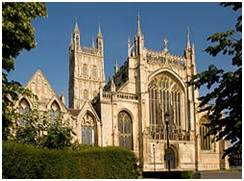
Gloucester Cathedral
Let us put an end to the unseemly media and public rowing over the re-interment of the remains of a once-anointed King. Let us take the attention temporarily from Leicester and York, and provide a public/media focus elsewhere, for a temporary hiatus, while the Esteemed Authorities resolve the issue of the primary subjects. (We can wrangle over Gloucester, instead.)
A nos moutons! What has Gloucester Cathedral to offer in place of either of the other two?
It is bigger than the formerly (until 1927) parish church of Leicester. It appears that size counts, in this issue. Tomb or floor slab?
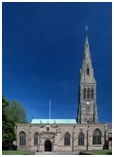
And it is prettier than Leicester…
Noble burials
Suitable tombs
Gloucester contains the alabaster tomb/effigy of Edward II.
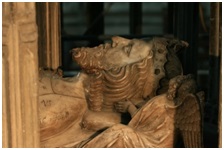
The Richard III Society commissioned and funded a design for a suitable, aesthetic RIII tomb. Apparently under dispute? by Leicester Cathedral. No room in the inn?
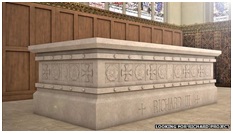
Richard III Tomb design (Source: Richard III Society)
Accomodation
Gloucester appears to be sufficiently large to accommodate a TOMB, not a floor slab, to be trodden underfoot…. (rather a slobby solution, do you think?)
Titles:
The main title of Richard III, before he took the crown, was DUKE of GLOUCESTER.
Contra?
Beyond his title, what affiliation has Gloucestershire to Richard III, of the House of York?
A quick aside about York

York Minster. As glorious a façade as that of Rouen.
The Chapter of York Minster published a statement on February 7 2013, which included the words: “…it commends Richard to Leicester’s care.” Richard, not King Richard III. They have a commemorative stained glass, in the king’s honour. Well, better than a floor slob…
And while we await the decision of Eminent Authorities to award the laurels to Leicester (with a floor slob), we can also argue about the merits of the king’s birthplace, Fotheringhay, bloodily redolent, of memories of Mary Stuart. Or Middleham, which could include coach tours to Haworth for pilgrims of varying stripes…
Please allow me to mention that this is not a serious post. It is strictly “tongue-in-cheek”, as an indirect comment on the media, etc. “wars”.
A Dwarf of our acquaintance, originally from Leicester, is wisely silent on the Wars. Obviously, he has quite enough to deal with, in retrieving Erebor for his family.

Thorin Oakenshield – The Hobbit (Source: RichardArmitageNet.com)
Richardarmitagenet Gallery. The Hobbit.
Guestpost by:
Fitzg
[Image Sources: As far as not otherwise mentioned, the images are Wikimedia Commons files.]

